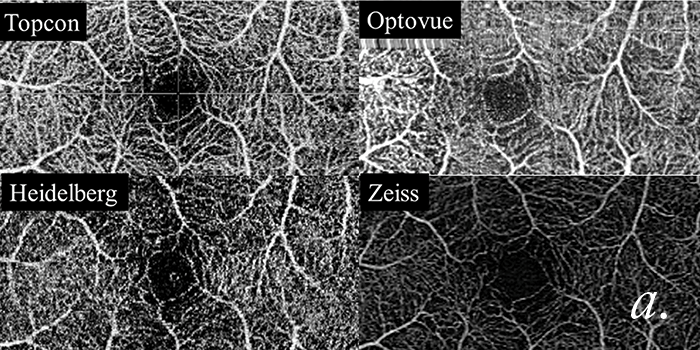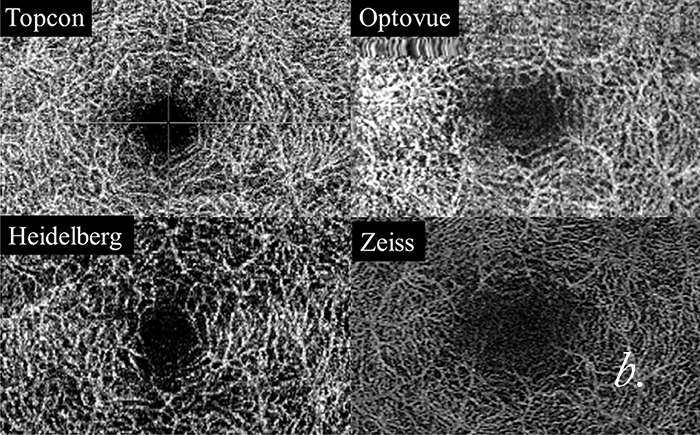
Articles that directly compare the wares of competitors are common in consumer markets but pretty rare in the healthcare space. And yet, rather than pitting Hi-Fi components, mobile phones or cars against each other, a recent article in PLOS ONE (1) compared OCT-angiography (OCT-A) modules from Heidelberg Engineering (Spectralis OCT2), Optovue (RTVue-XR), Topcon (DRI-OCT Triton) and Zeiss (Cirrus 5000-HD-OCT). There are a couple of caveats that should be noted up front. Heidelberg Engineering’s OCT2 module was still a prototype and the area it scanned was different to the other instruments (3 mm x 3 mm vs. 4.3 mm x 1.5 mm); the Optovue instrument was an older model that lacked eye tracking; and only 19 healthy subjects (with no history or presence of eye disease, cardiovascular disease or diabetes and a VA of 20/20 or better) were employed in the study, meaning that no diseased retinae were examined.

That said, each patient was scanned by each instrument, and all images – en-face OCT-A images of the superficial (SCP) and deep capillary plexuses (DCP; Figure 1) – were evaluated and scored by a panel of three independent imaging experts. Consensus gradings were performed for each scan after an inter-grader reliability assessment. The same publically-available software package – Angiotool – was used to assess SCP vessel density. So what did they find? There were no significant differences between the instruments in terms of Angiotool-determined overall vessel density and motion artifacts – but when it came to SCP image artifacts, the Zeiss and Topcon instruments were considered to be superior to the other devices. The foveal avascular zone (FAZ) border of the SCP slabs was “most appreciable” on the images taken with the Zeiss instrument, followed by the Optovue, and the FAZ of the DCP was most easily discerned on images from the Optovue device followed by the Heidelberg module. The numbers of discernable vessel bifurcations differed significantly between instruments (Zeiss 2 ± 0.9, Optovue 2.5 ± 1.2; Topcon 1.3 ± 0.7, Heidelberg 0.5 ± 0.6, p<0.001). Overall, the Zeiss module was better than the median in 90 percent of cases, the Optovue module better than the mean in 60 percent of cases, the Topcon module in 40 percent, and the Heidelberg (prototype) module in 10 percent – but these differences were not statistically significant between instruments. OCT-A is rapidly coming of age, and the instrument manufacturers continue to develop and improve upon the technology at a ferocious pace. Since the study was performed, the Optovue instrument has gained an eye tracking function, and the Heidelberg Spectralis OCT2 module is now no longer a prototype and is commercially available in many markets. Bottom line: this technology’s progress is so rapid that it’s clearly a topic that will need to be revisited on a regular basis.
References
- MR Munk et al., “OCT-angiography: A qualitative and quantitative comparison of 4 OCT-A devices”, PLoS ONE 12, 0177059 (2017). PMID: 28489918.
